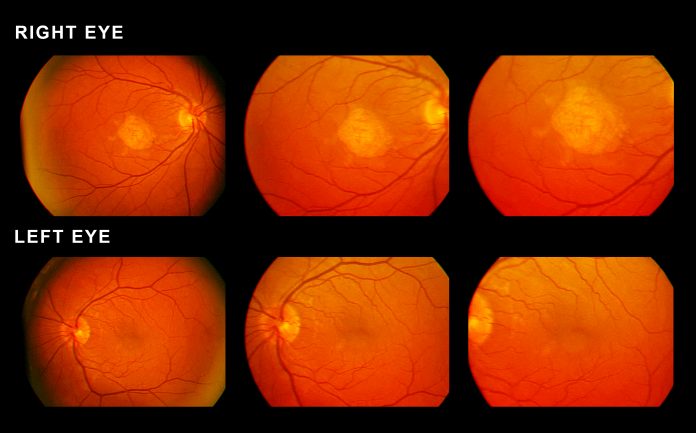Scientists have determined that interleukin-4 (IL-4), a protein that normally triggers a helpful immune response, may interact with bone marrow cells to promote harmful blood-vessel growth in age-related macular degeneration (AMD).
AMD is a neurodegenerative disorder that develops in elderly individuals and is a major cause of visual impairments. The pathology of AMD is coupled with senescence-associated para-inflammation, including the secretion of certain cytokines.
The purpose of this study, according to the authors, was to determine “whether bone marrow cells and IL-4 protect the photoreceptors from neurodegeneration, and whether they play regulatory roles in eyes with AMD.” To do this, they determined the concentration of IL-4 and other inflammatory cytokines in the aqueous humor of the eyes of AMD. They then determined whether IL-4 and bone marrow cells play roles in protecting the eye from abnormal angiogenesis using functional assays and global transcriptional profiling of bone marrow cells derived from endothelial progenitor cells (EPC).
The work is published in eLife, in a paper titled, “Role of IL-4 in bone marrow driven dysregulated angiogenesis and age-related macular degeneration.”
The findings suggest that an immune-stimulating protein called IL-4 and its receptor may be promising targets for new drugs to treat AMD, a common form of age-related vision loss.
In patients with AMD, inflammation in the eye triggers excessive growth of new blood vessels in the center of the retina.
This process damages the photoreceptors in the eye and leads to progressive vision loss. Normally, bone marrow cells help the body repair damaged tissues, while IL-4 helps suppress excessive blood vessel growth. Co-first author Takashi Baba, MD, PhD, junior associate professor in the division of ophthalmology and visual science at Tottori University, Japan, and his colleagues decided to look at whether these players might be helpful in patients with AMD. “The purpose of our study was to determine whether bone marrow cells and IL-4 protect the photoreceptors from neurodegeneration in patients with AMD,” Baba explained.
To do this, the team measured levels of IL-4 in the eyes of 234 patients with AMD and 104 older individuals undergoing surgery for cataracts. They found that those with AMD had higher levels of IL-4 than those undergoing surgery.
Next, they found that IL-4 was also elevated in mice with a condition that mimics AMD. To determine if IL-4 was helping or harming the animals, they administered them with IL-4 and found that it increased the excessive growth of blood vessels in the eye. An antibody that blocks IL-4 production reduced this blood-vessel growth. Mice with the AMD-like condition that were genetically engineered to lack IL-4 also had less blood-vessel growth.
“Our results show that IL-4 plays a crucial role in excessive blood-vessel growth by recruiting bone marrow cells that aid this growth to the lesion in the eye,” Baba said.
“These results were surprising and suggest that normally helpful immune responses can instead cause more harm,” added co-first author Dai Miyazaki, associate professor at the division of ophthalmology and visual science, Tottori University. “As IL-4 plays a key disease-promoting role in AMD, it may serve as a target for new treatments to treat this condition.”



